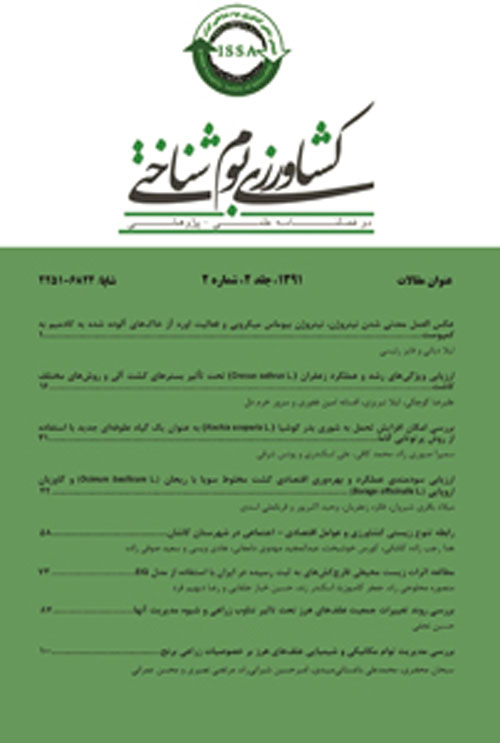Evaluation of growth indices for Black Seed, Marigold and Borage as medicinal plants at intercropping in replacement series
Author(s):
Abstract:
Introduction
Sustainable agriculture is the proper management of agricultural resources that meets the needs of human and guarantees the quality of agricultural production and environment and also retains the capacity of soil and water resources (Naghipoor Dehkordi et al., 2016). Hitherto, various research studies have shown the positive effect of intercropping on greater use of the land (LER), leaf area index and total dry matter, growth parameters, yield and other things. The people of the world turning to medicinal plants in recent decades along with numerous advantages of intercropping for monoculture have attracted the attention of farmers to the production of the medicinal plants via intercropping (Malik et al., 2011). Therefore, the objective of this study was to evaluate growth indices for three species of black seed (Nigella sativa L.), borage (Borago officinalis L.) and marigold (Calendula officinalis L.) in replacement intercropping series.Materials and metods: This experiment was conducted at the research field of Ferdowsi University of Mashhad during growing season of 2013-14. Treatments included double intercropping of black seed-marigold, black seed-borage and borage marigold-borage with ratios of 50:50, triple intercropping of black seed-marigold-borage with ratios of 33:33:33 and their monoculture. A weekly irrigation period was conducted and destructive sampling was carried out every two weeks. Measurement of daily changes in growth indices was done using relevant functions and Slidewrite and MS Excel were used, respectively, to fit functions to data and draw the figures.
Results And Discussions
The results showed that the highest amount of leaf area index (LAI) and total dry matter (TDM) of each plant of black seed, marigold and Borage was dedicated to their monoculture and the lowest amount of these was obtained through triple intercropping. The reason for this result could be related to reducing of the density of any studied plants in double and triple replacement intercropping. However, despite these results, the highest numbers of other growth indices such as relative growth rate (RGR), crop growth rate (CGR) and net assimilation rate (NAR) was obtained in intercropping treatments in which the highest value for each plant of black seed, marigold and borage was obtained in the triple intercropping treatment. Commenting on the present results, it can be noted that in intercropping due to more occupying of niches by crops, fewer niches can be gotten to weeds, so by reducing the number and density of weed species and avoiding the competition and their interaction with crops, can cause improved growth conditions for plants in intercropping. On the other hand intra-specific competition in intercropping are minimized and the positive impacts of intercropped species on each other leads to improvement in growth and, thereby, improvement of the growth indices.Conclusion
The results showed that, although leaf area index and total dry matter of intercropping treatments were lower than in monoculture due to the lower density of black seed, marigold and borage in replacement intercropping compared to their monoculture, due to the plants improved growing conditions in intercropping treatments, both the crop growth rate and net assimilation rate of the plants in intercropping treatments were higher than in monoculture. It has been proven that the effects of intercropping by its involvement in improved soil quality, increased carbon sequestration and reduced leaching of nitrogen has contributed greatly to agro ecological services (Cong et al., 2015). The results confirm the better environmental resources use of black seed, marigold and borage in intercropping treatments and their considerable effect on growth indexes of studied plant. Thus, according to the results, it seems that intercropping, especially triple intercropping of black seed, marigold and borage, can be used for ecological resource management.Keywords:
Language:
Persian
Published:
Journal of Agroecology, Volume:6 Issue: 2, 2017
Page:
179
https://magiran.com/p1681001
مقالات دیگری از این نویسنده (گان)
-
Role of Rural Women in the Sustainability of Iran's Agroecosystems
Anahita Valiollahi Bisheh, Alireza Koocheki *, , Minoo Moallem
Agroecology journal, -
Evaluation of Local Methods Employed to Increase Biodiversity in the Agroecosystems: A Case Study in Western Khorasan Province
Maryam Javadi, Mohsen Jahan *, Mahdi Nassiri Mahallati
Agroecology journal,



